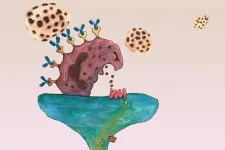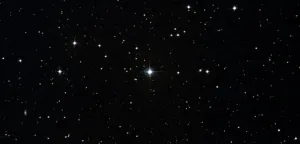(Press-News.org) Astronomers are winding back the clock on the expanding remains of a nearby, exploded star. By using NASA's Hubble Space Telescope, they retraced the speedy shrapnel from the blast to calculate a more accurate estimate of the location and time of the stellar detonation.
The victim is a star that exploded long ago in the Small Magellanic Cloud, a satellite galaxy to our Milky Way. The doomed star left behind an expanding, gaseous corpse, a supernova remnant named 1E 0102.2-7219, which NASA's Einstein Observatory first discovered in X-rays. Like detectives, researchers sifted through archival images taken by Hubble, analyzing visible-light observations made 10 years apart.
The research team, led by John Banovetz and Danny Milisavljevic of Purdue University in West Lafayette, Indiana, measured the velocities of 45 tadpole-shaped, oxygen-rich clumps of ejecta flung by the supernova blast. Ionized oxygen is an excellent tracer because it glows brightest in visible light.
To calculate an accurate explosion age, the astronomers picked the 22 fastest moving ejecta clumps, or knots. The researchers determined that these targets were the least likely to have been slowed down by passage through interstellar material. They then traced the knots' motion backward until the ejecta coalesced at one point, identifying the explosion site. Once that was known, they could calculate how long it took the speedy knots to travel from the explosion center to their current location.
According to their estimate, light from the blast arrived at Earth 1,700 years ago, during the decline of the Roman Empire. However, the supernova would only have been visible to inhabitants of Earth's southern hemisphere. Unfortunately, there are no known records of this titanic event.
The researchers' results differ from previous observations of the supernova's blast site and age. Earlier studies, for example, arrived at explosion ages of 2,000 and 1,000 years ago. However, Banovetz and Milisavljevic say their analysis is more robust.
"A prior study compared images taken years apart with two different cameras on Hubble, the Wide Field Planetary Camera 2 and the Advanced Camera for Surveys (ACS)," Milisavljevic said. "But our study compares data taken with the same camera, the ACS, making the comparison much more robust; the knots were much easier to track using the same instrument. It's a testament to the longevity of Hubble that we could do such a clean comparison of images taken 10 years apart."
The astronomers also took advantage of the sharp ACS images in selecting which ejecta clumps to analyze. In prior studies, researchers averaged the speed of all of the gaseous debris to calculate an explosion age. However, the ACS data revealed regions where the ejecta slowed down because it was slamming into denser material shed by the star before it exploded as a supernova. Researchers didn't include those knots in the sample. They needed the ejecta that best reflected their original velocities from the explosion, using them to determine an accurate age estimate of the supernova blast.
Hubble also clocked the speed of a suspected neutron star--the crushed core of the doomed star--that was ejected from the blast. Based on their estimates, the neutron star must be moving at more than 2 million miles per hour from the center of the explosion to have arrived at its current position. The suspected neutron star was identified in observations with the European Southern Observatory's Very Large Telescope in Chile, in combination with data from NASA's Chandra X-ray Observatory.
"That is pretty fast and at the extreme end of how fast we think a neutron star can be moving, even if it got a kick from the supernova explosion," Banovetz said. "More recent investigations call into question whether the object is actually the surviving neutron star of the supernova explosion. It is potentially just a compact clump of supernova ejecta that has been lit up, and our results generally support this conclusion."
So the hunt may still be on for the neutron star. "Our study doesn't solve the mystery, but it gives an estimate of the velocity for the candidate neutron star," Banovetz said.
INFORMATION:
Banovetz will present the team's findings Jan. 14 at the American Astronomical Society's winter meeting.
The Hubble Space Telescope is a project of international cooperation between NASA and ESA (European Space Agency). NASA's Goddard Space Flight Center in Greenbelt, Maryland, manages the telescope. The Space Telescope Science Institute (STScI) in Baltimore, Maryland, conducts Hubble science operations. STScI is operated for NASA by the Association of Universities for Research in Astronomy in Washington, D.C.
Credits: NASA, ESA, and J. Banovetz and D. Milisavljevic (Purdue University)
Claire Andreoli
NASA's Goddard Space Flight Center
301-286-1940
claire.andreoli@nasa.gov
Donna Weaver / Ray Villard
Space Telescope Science Institute, Baltimore, Maryland
410-338-4493 / 410-338-4514
dweaver@stsci.edu / villard@stsci.edu
John Banovetz / Danny Milisavljevic
Purdue University, West Lafayette, Indiana
jbanovet@purdue.edu / dmilisav@purdue.edu
In addition to a skin rash, many eczema sufferers also experience chronic itching, but sometimes that itching can become torturous. Worse, antihistamines -- the standard treatment for itching and allergy -- often don't help.
New research from Washington University School of Medicine in St. Louis indicates that allergens in the environment often are to blame for episodes of acute itch in eczema patients, and that the itching often doesn't respond to antihistamines because the itch signals are being carried to the brain along a previously unrecognized pathway that current drugs don't target.
The new findings, published ...
The sun is the only star in our system. But many of the points of light in our night sky are not as lonely. By some estimates, more than three-quarters of all stars exist as binaries -- with one companion -- or in even more complex relationships. Stars in close quarters can have dramatic impacts on their neighbors. They can strip material from one another, merge or twist each other's movements through the cosmos.
And sometimes those changes unfold over the course of a few generations.
That is what a team of astronomers from the University of Washington, Western Washington University and the University ...
There's a 7-fold unexplained variation in rates of euthanasia across The Netherlands, reveals an analysis of health insurance claims data, published online in the journal BMJ Supportive & Palliative Care.
It's not clear if these differences relate to underuse, overuse, or even misuse, say the researchers.
The Netherlands was the first country in the world to legalise euthanasia and physician-assisted suicide, introducing preliminary legislation in 1994, followed by a fully fledged law in 2002. The practice has been tolerated, however, since 1985.
Official data show that the number of euthanasia cases has risen more or less continuously since 2006, reaching 6361 in 2019. These cases ...
Climate change impacts, affecting primarily ecosystems' functions and consequently human sectors, have become a crucial topic. Observed and expected variations in climate conditions can in fact undermine the ecosystems' ecological equilibrium: average climate patterns, mainly represented by intra-annual (monthly to seasonal) temperature and precipitation cycle, directly influence the distribution, abundance and interactions of biological species.
During the long history of scientific research on the relationships between climate and Earth's communities, ...
BIRMINGHAM, Ala. - Use of the diabetes drug metformin -- before a diagnosis of COVID-19 -- is associated with a threefold decrease in mortality in COVID-19 patients with Type 2 diabetes, according to a racially diverse study at the University of Alabama at Birmingham. Diabetes is a significant comorbidity for COVID-19.
"This beneficial effect remained, even after correcting for age, sex, race, obesity, and hypertension or chronic kidney disease and heart failure," said Anath Shalev, M.D., director of UAB's Comprehensive Diabetes Center and leader of the study.
"Since similar results have now been obtained in different populations from around the world -- including China, France and a UnitedHealthcare analysis -- this suggests that the ...
Ignoring a colleague's greeting or making a sarcastic comment in the workplace may actually do more harm than intended, according to West Virginia University research.
Perceived low-grade forms of workplace mistreatment, such as avoiding eye contact or excluding a coworker from conversation, can amplify suicidal thoughts in employees with mood disorders, based on a study by Kayla Follmer, assistant professor of management, and Jake Follmer, assistant professor of educational psychology.
"We know from prior research that minor forms of workplace mistreatment reduce employee engagement," Kayla Follmer said. "But our paper provided an explanation for ...
New York, NY (January 14, 2020) -- Girls who are emotionally neglected or severely sexually abused early in their lives report riskier sexual behaviors during adolescence, Mount Sinai researchers report. The findings highlight the need--and suggest the potential for tailored approaches--to promote healthy sexual development in vulnerable populations.
The researchers identified four distinct patterns of neglect and sexual abuse in low-income, predominantly Black and/or Latina girls and young women that led to distinct trajectories of risky sexual behavior during adolescence. Their findings were published in Child Development in January.
The study was the first of its kind to identify categories of maltreatment among adolescent girls of color in an urban setting that correspond with measurable ...
The COVID-19 pandemic, which claimed more than 336,000 lives in the United States in 2020, has significantly affected life expectancy, USC and Princeton researchers have found.
The researchers project that, due to the pandemic deaths last year, life expectancy at birth for Americans will shorten by 1.13 years to 77.48 years, according to their study published Thursday in the Proceedings of the National Academy of Sciences.
That is the largest single-year decline in life expectancy in at least 40 years and is the lowest life expectancy estimated since ...
A team of biophysicists from the University of Massachusetts Amherst and Penn State College of Medicine set out to tackle the long-standing question about the nature of force generation by myosin, the molecular motor responsible for muscle contraction and many other cellular processes. The key question they addressed - one of the most controversial topics in the field - was: how does myosin convert chemical energy, in the form of ATP, into mechanical work?
The answer revealed new details into how myosin, the engine of muscle and related motor proteins, transduces energy.
In the end, their unprecedented research, meticulously ...
Humans, mammals and birds that live in a particular environment share a common set of behavioral traits, according to a new study, which identifies a local convergence of foraging, reproductive and social behaviors across species. The findings, based on studying more than 300 small-scale human hunter-gatherer populations, support one of the central tenets of human behavioral ecology - that ecological forces select for various behaviors in distinct environments, driving behavioral diversity worldwide. The origin and evolution of human behavior are uncertain and debated. While some suggest ...






